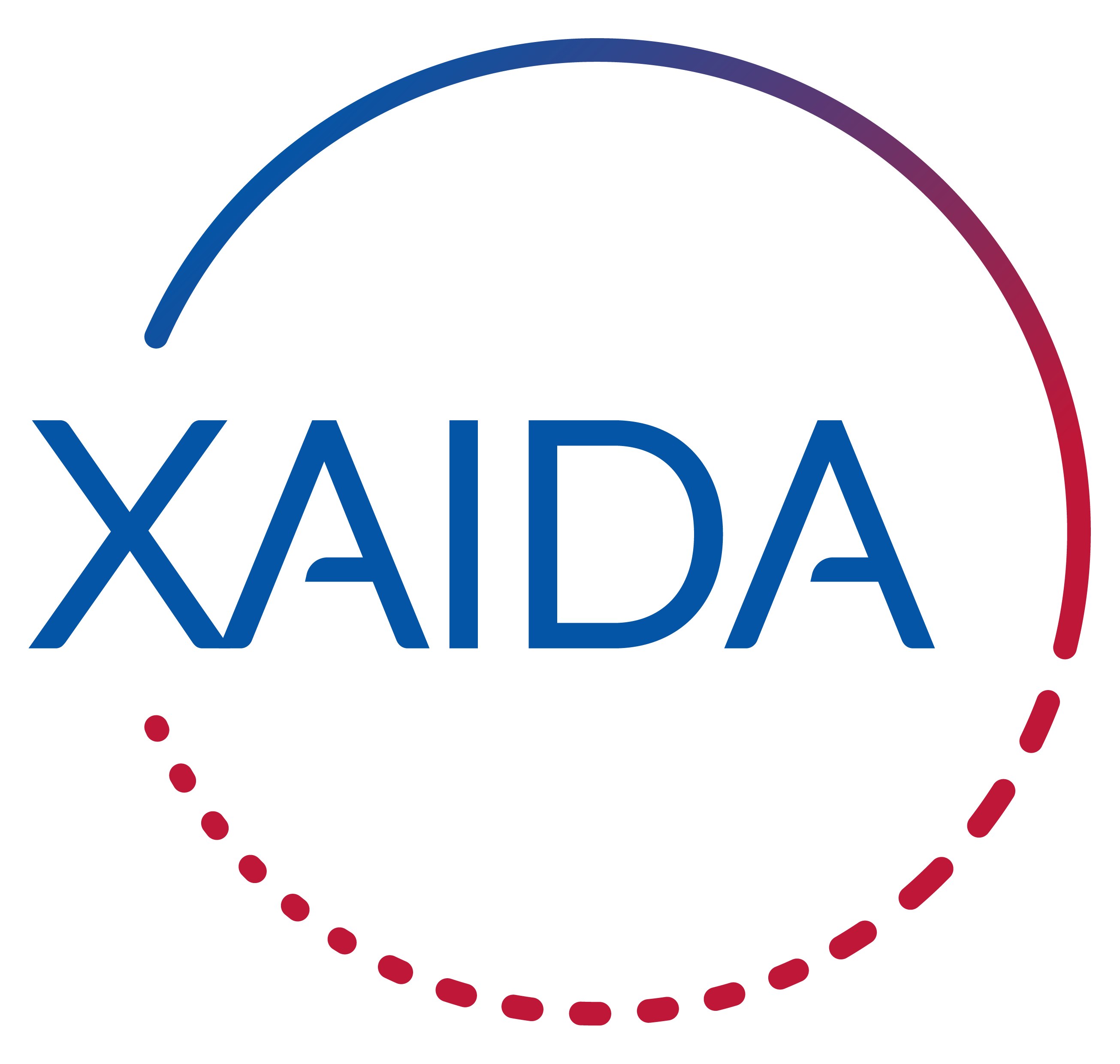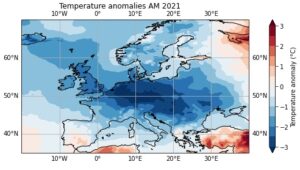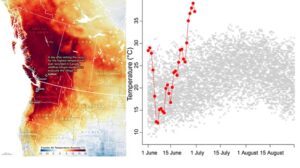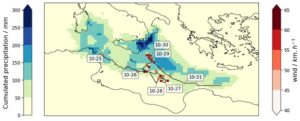EUROPEAN DROUGHT AND HEATWAVE IN 2022
In the summer of 2022, western and central Europe faced significant soil moisture shortages due to a combination of low rainfall and high temperatures. This drought was one of the worst the region had seen since at least the mid-1900s, leading to the question whether and to what extent this is caused by our changing climate.
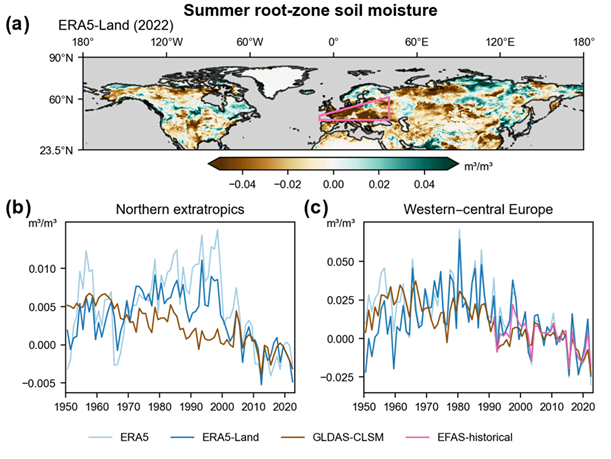
Figure1: Mean summer (June–August) root zone soil moisture in 2022 over the northern extratropics (NHET), shown for the ERA5-Land dataset and expressed as anomalies with respect to 1950–2022. Western–central Europe (WCE) is highlighted by the pink contour. From Schumacher et al, 2024 (https://doi.org/10.5194/esd-15-131-2024)
Event definition
XAIDA has defined several definitions to study different aspects of the drought and its impacts:
- We study how climate change might have affected the frequency and severity of soil moisture deficits in 2022, specifically in the surface and root zones, which are important for understanding agricultural drought. Our focus is on the western-central Europe (WCE) region, as defined in the IPCC AR6 report. We concentrate on June–August, the time when droughts are most widespread in the northern latitudes and when the 2022 drought conditions were at their worst. Since temperature and precipitation have a strong impact on agricultural drought, we also analyze the changes in summertime temperature and rainfall for the same regions.
- By focussing on central and southern Europe, we also analyze soil moisture, river discharge, and total water storage to gain a full picture of the drought’s impact. For this, we use a combination of hydrological and land-surface models along with precipitation and temperature data from observations and climate models. By taking a storyline approach, we inspect the contribution of precipitation and temperature anomalies to the hydrological and soil moisture drought. Given the meteorological conditions driving the drought, we assess how human-induced climate change affected drought intensity and spatial extent. We further quantify the role of lagged effects of human-induced climate change, that is the importance of warming-driven drying of the soil that occurred before the hydrological year of 2022
- We complement these event definitions by investigating the role of soil temperatures, using TX7day extremes over Europe.
Objectives
XAIDA aims at:
- Detecting drought trends over Europe and attributing changes in extreme droughts to climate change, including effects of changes in temperature and rainfall.
- Improving the understanding of the driving physical mechanisms of this event, including human-induced climate change effects, by using a storyline approach.
- Understanding how soil temperatures affect drought and air temperatures, and how soil moisture–temperature feedbacks contribute to the evolution of hot extremes in a warming climate.
- Understanding whether and how atmospheric circulation patterns similar to the one associated with the 2022 drought are affected by climate change.
Study results
Attributing heatwaves to climate change is challenging (van Oldenborgh et al., 2022), but attributing other extreme events can be even more difficult, especially those that are not well observed, like the 2022 European agro-ecological (soil moisture) drought. Despite these challenges, WP6 has conducted the first large-scale study on soil drought attribution (Schumacher et al., 2024). Using a probabilistic approach and building on several observational lines of evidence as well as climate model output, we found that human-induced climate change has made summer soil moisture droughts more likely, not only in west-central Europe but also in the northern extratropics. Furthermore, these droughts are expected to become even more likely with further global warming.
Using a « storyline approach » to study the 2022 drought event, we explicitly simulated it with two independent physical models, incorporating both observed and counterfactual meteorological data. Our simulations show that while precipitation deficits were the main driver of the drought, human-induced global warming contributed to over 30% of the drought intensity and its spatial extent via enhanced evaporation. Interestingly, we found that 14–41% of the human-induced climate change contribution was mediated by warming-driven drying of the soil that occurred before the 2022 hydrological year. This highlights the importance of considering the lagged effects of climate change, as failing to do so could lead to underestimating associated risks (Bevacqua et al., 2024).
García-García et al. (2023) show that soil hot extremes are increasing faster than air hot extremes, with an average increase of 0.7°C per decade in intensity and a doubling of their frequency in Central Europe. We also identify soil temperature as a key factor in the soil moisture-temperature feedback loop. During dry and warm conditions, the energy absorbed by the soil warms it further, releasing more sensible heat and raising surface air temperatures. This increase in air temperature raises the atmospheric demand for water, leading to higher soil evaporation, which can further dry and warm the soil. This feedback process contributes to the intensification of hot extremes in a warming climate. This adds further evidence to the importance of soil moisture-temperature feedbacks in a changing climate.
Finally, Faranda et al. (2023) explored the link between atmospheric circulation and climate change by using a method called circulation analogs, which helps us identify atmospheric patterns from between 1836-1936 and 1942-2021 that were similar to those in 2022. The 2022 drought was linked to a persistent high-pressure system over Western Europe. When we looked at similar patterns from 1941 to 2021, we found that they showed larger and more intense atmospheric anomalies, as well as higher surface temperatures, compared to the 1836–1915 period. These factors worsened the drought by expanding the affected area and increasing soil drying through higher evapotranspiration. While the specific atmospheric pattern linked to the 2022 drought has not become more frequent in recent decades, we cannot rule out the influence of the Atlantic Multidecadal Oscillation.
Conclusion
Dry soils make extreme heat worse, while higher air temperatures dry out the soil faster through increased evaporation. This highlights the importance of studying the combined effects of these events, including ones we may not yet recognize. It also emphasizes the need to better understand how soil moisture and temperature interact, as these feedbacks, along with anticyclonic weather patterns, link heat and drought.
References
Bevacqua, E., Rakovec, O., Schumacher, D.L., Kumar, R., Thober, S., Samaniego, L., Seneviratne, S. I., Zscheischler, J., (2024). “Direct and lagged climate change effects intensified the 2022 European drought“. Nat. Geosci. https://doi.org/10.1038/s41561-024-01559-2
Faranda, D., Pascale, S., Bulut, B., (2023), Persistent anticyclonic conditions and climate change exacerbated the exceptional 2022 European-Mediterranean drought, Environmental Research Letters, 18 034030, https://doi.org/10.1088/1748-9326/acbc37
García-García A., Cuesta-Valero FJ., Miralles DG., Mahecha MD., Quaas J., Reichstein M., Zscheischler J. and Peng J.: “Soil heat extremes can outpace air temperature extremes”, Nat. Clim. Chang. 13, 1237–1241 (2023) https://doi.org/10.1038/s41558-023-01812-3
Schumacher D. L., Zachariah M., Otto F., Barnes C., Philip S., Kew S., Vahlberg M., Singh R., Heinrich D., Arrighi J., van Aalst, M., Hauser M., Hirschi M., Bessenbacher V., Gudmundsson L., Beaudoing H. K., Rodell M., Li S., Yang W., Vecchi G. A., Harrington L. J., Lehner F., Balsamo G., and Seneviratne S. I.: “Detecting the human fingerprint in the summer 2022 western–central European soil drought”, Earth Syst. Dynam., 15, 131–154 (2024) https://doi.org/10.5194/esd-15-131-2024
J., Wehner M. F., Vautard R., Otto F. E. L., Seneviratne S. I., Stott P. A., et al.: ”Attributing and projecting heatwaves is hard: We can do better”, Earth’s Future, 10, e2021EF002271 (2022) https://doi.org/10.1029/2021EF002271
 This project has received funding from the European Union’s Horizon 2020 research and innovation programme under grant agreement No 101003469.
This project has received funding from the European Union’s Horizon 2020 research and innovation programme under grant agreement No 101003469.
